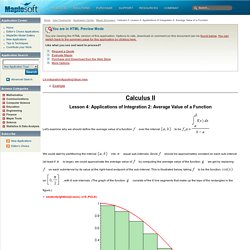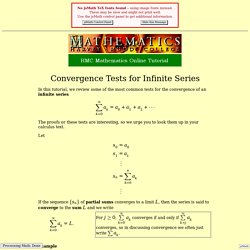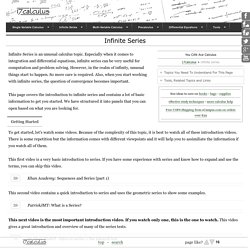

Riemann Sums Setup. In the applet below, you the instructor can customize appearance, example problems and basic functionality of a student applet.To use this applet with your own settings, just follow the simple directions below!

Download the Flash player file riemann.swf and riemann.html to a subdirectory (a.k.a., folder) on your website. Click on the second of these files to see what the applet will look like. Use the applet below to make your decisions and press the DONE button. Look here to see an explanation of the various choices you have. Calculus II: Lesson 4: Applications of Integration 2: Average Value of a Function - Application Center. L4-integrationAppsAvgValue.mwsExample Calculus II Lesson 4: Applications of Integration 2: Average Value of a Function Let's examine why we should define the average value of a function over the interval.

Convergence Tests for Infinite Series - HMC Calculus Tutorial. Convergence Tests for Infinite Series In this tutorial, we review some of the most common tests for the convergence of an infinite series \sum_{k=0}^{\infty} a_k = a_0 + a_1 + a_2 + \cdots The proofs or these tests are interesting, so we urge you to look them up in your calculus text.

Let \begin{eqnarray*} s_0 & = & a_0 \\ s_1 & = & a_1 \\ & \vdots & \\ s_n & = & \sum_{k=0}^{n} a_k \\ & \vdots & \end{eqnarray*} If the sequence \{ s_n \} of partial sums converges to a limit L, then the series is said to converge to the sum L and we write Example Consider the geometric series \sum_{k=0}^{\infty} x^k. The n^{th} partial sum is s_n = 1 + x + x^{2} + \cdots + x^{n}. Multiplying both sides by x, xs_n = x + x^{2} + x^{3} + \cdots + x^{n+1}. Subtracting the second equation from the first, (1-x)s_n = 1-x^{n+1}, so for x \not= 1, An Introduction to Lagrange Multipliers. Lagrange multipliers are used in multivariable calculus to find maxima and minima of a function subject to constraints (like "find the highest elevation along the given path" or "minimize the cost of materials for a box enclosing a given volume").

It's a useful technique, but all too often it is poorly taught and poorly understood. With luck, this overview will help to make the concept and its applications a bit clearer. Be warned: this page may not be what you're looking for! If you're looking for detailed proofs, I recommend consulting your favorite textbook on multivariable calculus: my focus here is on concepts, not mechanics.
(Comes of being a physicist rather than a mathematician, I guess.) Here's a basic outline of this discussion: When are Lagrange multipliers useful? One of the most common problems in calculus is that of finding maxima or minima (in general, "extrema") of a function, but it is often difficult to find a closed form for the function being extremized. Final thoughts.
Riemann Sums Setup. From Wolfram MathWorld. Integration By Parts Examples, Tricks And A Secret How-To. Integration by parts is a "fancy" technique for solving integrals.

It is usually the last resort when we are trying to solve an integral. The idea it is based on is very simple: applying the product rule to solve integrals. So, we are going to begin by recalling the product rule. Using the fact that integration reverses integration we'll arrive at a formula for integrals, called the integration by parts formula. We'll then solve some examples also learn some tricks related to integration by parts. The Integration by Parts Formula In the following video I explain the idea that takes us to the formula, and then I solve one example that is also shown in the text below.
In the video I use a notation that is more common in textbooks. Let's begin by recalling the product rule for derivatives: This formula is easy to memorize. Now, what we have is an equality of two functions. Let's find the antiderivatives of both sides: Now, arranging this equality: Look at that. Let's see an example. 17Calculus - Infinite Series. Infinite Series is an unusual calculus topic.

Especially when it comes to integration and differential equations, infinite series can be very useful for computation and problem solving. However, in the realm of infinity, unusual things start to happen. So more care is required. Also, when you start working with infinite series, the question of convergence becomes important.
This page covers the introduction to infinite series and contains a lot of basic information to get you started. To get started, let's watch some videos.